Journal list menu
Export Citations
Download PDFs
Editor's Choice
EDITORIALS
Publish and perish: how plagiarism can penalize perpetrators
- Pages: 549-551
- First Published: 16 March 2015
Sentinel node biopsy in cutaneous melanoma: time for consensus to better inform patient choice
- Pages: 552-554
- First Published: 16 March 2015
COMMENTARIES
Chemical exposure in fetal/early life: a possible explanation for the rapid increase in atopic dermatitis incidence
- Page: 555
- First Published: 16 March 2015
Don't stop antithrombotics for cutaneous surgery: just do it now!
- Pages: 555-556
- First Published: 16 March 2015
Pulsed dye laser treatment of superficial basal cell carcinoma
- Pages: 557-558
- First Published: 16 March 2015
Thinner melanomas and improved survival among men in Sweden from 1997 to 2011
- Pages: 559-560
- First Published: 16 March 2015
Head and neck melanoma: pattern of sun exposure and histological subtypes
- Pages: 560-561
- First Published: 16 March 2015
Recurrence rates in localized scleroderma (morphoea)
- Pages: 562-563
- First Published: 16 March 2015
A new way of targeting phototherapy to body sites where it is needed
- Pages: 563-564
- First Published: 16 March 2015
To (anti-)TNF or not (anti-)TNF? That is the question in pemphigus
- Pages: 564-565
- First Published: 16 March 2015
PUTTING PAPERS INTO PRACTICE
No survival benefit for patients with melanoma undergoing sentinel lymph node biopsy: critical appraisal of the Multicenter Selective Lymphadenectomy Trial-I final report
- Pages: 566-571
- First Published: 16 March 2015
Multicenter Selective Lymphadenectomy Trial-I confirms the central role of sentinel node biopsy in contemporary melanoma management : Response to ‘No survival benefit for patients with melanoma undergoing sentinel lymph node biopsy: critical appraisal of the Multicenter Selective Lymphadenectomy Trial-I final report’
- Pages: 571-573
- First Published: 16 March 2015
REVIEW ARTICLES
Psoriasis treatment and management – a systematic review of full economic evaluations
- Pages: 574-583
- First Published: 16 October 2014
What's already known about this topic?
- Current medication can provide effective control of psoriasis symptoms.
- The cost of treatment can be high, but may be cost-effective.
What does this study add?
- A comprehensive summary and critique of full economic evaluations of psoriasis treatment and management published between January 1998 and April 2014.
- Identification of key methodological issues and reasons why estimates of cost-effectiveness are uncertain.
- Research recommendations to inform practice and policy for the integrated care of people with psoriasis.
T helper cell 2 immune skewing in pregnancy/early life: chemical exposure and the development of atopic disease and allergy
- Pages: 584-591
- First Published: 29 October 2014
What's already known about this topic?
- Over the last 50 years there has been an epidemic of atopic disease and associated allergy, the environmental causes of which have not been established.
What does this study add?
- The physiological T helper (Th) 2 cell skewing of pregnancy and early life, and how accentuation of this Th2 skewing is associated with development of atopic disease and allergy is reviewed and highlighted.
- We postulate that certain types of exposures to chemicals can accentuate this Th2 skewing.
- We postulate an alternative explanation, which is independent of the hygiene hypothesis, for the inverse association between birth order and atopic allergy.
Onychomadesis: literature review
- Pages: 592-596
- First Published: 16 August 2014
What's already known about this topic?
- Onychomadesis is characterized by separation of the nail plate from the matrix with persistent attachment to the nail bed and often but not always, eventual shedding. Onychomadesis has been associated with infection, autoimmune disease, critical illness, and medications.
What does this study add?
- To our knowledge a literature review of all associations with onychomadesis has not been completed previously.
Perioperative management of and recommendations for antithrombotic medications in dermatological surgery
- Pages: 597-605
- First Published: 21 August 2014
What's already known about this topic?
- The number of patients on antithrombotic medications undergoing cutaneous surgery is steadily increasing.
- There are no strict guidelines on perioperative management of these agents and the data on bleeding complications is contradictory.
What does this study add?
- This study provides an up-to-date comprehensive approach to the management of antithrombotic medications in patients undergoing cutaneous surgery.
- The available data on warfarin, aspirin and clopidogrel is sufficient to recommend that these medications be continued throughout cutaneous surgical procedures.
- The risk of bleeding complications in patients on antithrombotic medications can be minimized by meticulous surgical techniques, elaborate haemostasis, pressure dressings and close postoperative follow-up.
Stretch marks during pregnancy: a review of topical prevention
- Pages: 606-615
- First Published: 25 September 2014
What's already known about this topic?
- Striae gravidarum (SG), or stretch marks developing during pregnancy, can be disfiguring, causing emotional and psychological distress.
- Studies specifically addressing the prevention of SG during pregnancy are sparse.
What does this study add?
- We review topical modalities that have been used specifically for preventing SG during pregnancy.
- We conclude that reliable methods for preventing SG are scarce, and that topical modalities generally lack strong evidence from rigorous, well-designed trials with ample numbers of subjects.
SYSTEMATIC REVIEWS
Evidence-based topical treatments for tinea cruris and tinea corporis: a summary of a Cochrane systematic review
- Pages: 616-641
- First Published: 07 October 2014
What's already known about this topic?
- Tinea cruris and tinea corporis are common fungal infections of the skin.
- A range of treatment options is available but it is unclear which is the most effective.
What does this study add?
- All included treatments appeared to be effective but most comparisons, except for terbinafine and naftifine, were only evaluated in single studies.
- Owing to limitations in study design and reporting, the quality of the evidence was graded low to very low.
Paediatric mastocytosis: a systematic review of 1747 cases
- Pages: 642-651
- First Published: 08 February 2015
What's already known about this topic?
- The clinical and genetic features and outcomes of mastocytosis differ for the adult and paediatric forms.
- Since paediatric mastocytosis was linked to mutations in c-Kit in 2010, it has been considered a clonal disease.
- In 1963, Caplan reported that spontaneous regression occurs in the majority of cases of paediatric mastocytosis, and no predictive factors have been identified.
What does this study add?
- This extensive review points out that the outcome in some paediatric cases is fatal, that KIT mutations are rarely studied and that predictive factors are still unknown.
- We suggest that long-term follow-up of children is necessary and that prospective studies are warranted to evaluate the prognostic value of sequencing KIT.
Limited exposure to ambient ultraviolet radiation and 25-hydroxyvitamin D levels: a systematic review
- Pages: 652-661
- First Published: 03 February 2015
What's already known about this topic?
- Hypovitaminosis D is common worldwide; adequate vitamin D levels are associated with improved health outcomes.
- Vitamin D can be obtained from the diet or through oral supplementation, or synthesized in human skin following exposure to ultraviolet radiation (UVR).
- Many authorities advocate that UVR exposure is essential for adequate vitamin D levels; however, UVR exposure can lead to skin cancer development, resulting in approximately 13 million skin cancers worldwide per annum.
What does this study add?
- This study demonstrates that many healthy adults in different populations across the world can maintain adequate serum vitamin D levels despite negligible UVR exposure for several months of the year.
- Public health campaigns promoting a high vitamin D diet or supplements to healthy adults could positively impact the burden to the individual and the health service of inadequate vitamin D levels and could avoid the negative sequelae of UVR exposure.
Original articles
CLINICAL AND LABORATORY INVESTIGATIONS
CD271 is expressed in melanomas with more aggressive behaviour, with correlation of characteristic morphology by in vivo reflectance confocal microscopy
- Pages: 662-668
- First Published: 26 July 2014
What's already known about this topic?
- Human malignant melanoma contains morphologically heterogeneous populations of cells and expresses different markers of stemness.
- Reflectance confocal microscopy (RCM) represents a new imaging tool for more accurate melanoma detection, which enables the in vivo visualization of cell morphology.
What does this study add?
- Melanomas with atypical cells organized in large dermal nests, recognized by RCM, correlate to CD271 positivity and high potential for malignancy.
- This is probably due to the presence of a cell type intrinsically predisposed to invasion.
DERMATOLOGICAL SURGERY AND LASERS
Topical axitinib suppresses angiogenesis pathways induced by pulsed dye laser
- Pages: 669-676
- First Published: 05 October 2014
What's already known about this topic?
- The regeneration of blood vessels in port-wine stain (PWS) after pulsed dye laser treatment is a critical barrier that must be overcome to achieve an adequate therapeutic outcome.
- Activation of angiogenesis pathways induced by PDL contributes to PWS blood vessel recurrence.
What does this study add?
- Topical application of 0·5% axitinib can systematically suppress PDL-induced angiogenesis.
- We propose a potentially new therapeutic strategy using PDL + axitinib for the clinical management of patients with PWS.
The role of the 595-nm pulsed dye laser in treating superficial basal cell carcinoma: outcome of a double-blind randomized placebo-controlled trial
- Pages: 677-683
- First Published: 12 July 2014
What's already known about this topic?
- Pulsed dye lasers (PDLs) are increasingly used for treating basal cell carcinomas (BCCs).
- However, so far there have been no sufficiently powered randomized controlled trials (RCTs) in the literature analysing the efficacy and safety of these devices.
What does this study add?
- To the best of our knowledge, this is the first RCT that analyses the 595-nm PDL in the treatment of superficial BCC at uncritical anatomical sites (trunk and extremities) with a follow-up of 6 months.
Prospective comparison treatment of 595-nm pulsed-dye lasers for virgin port-wine stain
- Pages: 684-691
- First Published: 18 August 2014
What's already known about this topic?
- Pulsed-dye laser (PDL) was one of the first widespread treatments for port-wine stain (PWS). Significant advances in the technique of PDL and its efficacy and safety for treating PWS have been demonstrated in previous studies.
- Vbeam® and Cynergy® are both 595-nm PDL systems that have been widely used to treat PWS lesions. No prior study has compared the efficacy of the two pieces of equipment.
What does this study add?
- This is the first prospective side-by-side comparison study of 595-nm PDL devices.
- Our results suggest that Vbeam may have higher efficacy in the treatment of PWS than Cynergy. Despite using supposedly equivalent fluences in 595-nm PDLs, equivalent clinical results cannot be guaranteed.
DERMATOPATHOLOGY
iSlide: a ‘big picture’ interactive teledermatopathology e-learning system
- Pages: 692-699
- First Published: 17 July 2014
What's already known about this topic?
- Teledermatopathology is the application of telemedicine to dermatopathology.
- Teledermatopathology is potentially similar to face-to-face interaction in dermatopathology.
- Through the effective use of health information technology, telemedicine makes it possible for health care to be universally and pervasively accessible to all.
What does this study add?
- The iSlide system utilizes digital slides to improve training efficiency and reduces education and training costs in dermatopathology.
- The iSlide e-learning platform can integrate with social network applications such as Facebook to further enhance interactive discussions.
EPIDEMIOLOGY AND HEALTH SERVICES RESEARCH
Trends in cutaneous malignant melanoma in Sweden 1997–2011: thinner tumours and improved survival among men
- Pages: 700-706
- First Published: 16 October 2014
What's already known about this topic?
- Patient survival and the proportion of thin cutaneous malignant melanoma (CMM) has been rising over time in most Western countries, although the corresponding rate of improvement of survival appears to have declined in Sweden at the end of the last millennium.
What does this study add?
- Swedish nationwide time trends of tumour thickness in CMM have been analysed for the first time.
- A shift over time towards thinner CMMs for men was accompanied by a 19% improved 5-year CMM-specific survival.
- Corresponding changes were not observed for women, although a superior 5-year CMM-specific survival still exists compared with that of men, motivating a continued need for improved secondary preventive actions for men.
Clinical and histological features of head and neck melanoma: a population-based study in France
- Pages: 707-715
- First Published: 21 October 2014
What's already known about this topic?
- Head and neck melanomas (HNMs) are frequent, occur in elderly people and have a poor prognosis.
- Population-based data on HNMs remain limited, and few studies have included a comprehensive comparison with melanomas at other sites (MOS).
What does this study add?
- In this population-based French study, HNMs differed from MOS by age of occurrence, histological type and a higher proportion of in situ cases, contrasting with a higher proportion of thick tumours.
- HNMs located in the peripheral and central areas of the head and neck had different clinical and histological features.
- Different patterns of sun exposure could explain these differences. Specific prevention messages targeting HNMs should be developed.
Hypochromic vitiligo: delineation of a new entity
- Pages: 716-721
- First Published: 25 September 2014
What's already known about this topic?
- The classification of vitiligo has important implications.
- Few observations of vitiligo minor/hypochromic vitiligo, a rare entity affecting mainly individuals with dark skin types, have been reported.
What does this study add?
- We herein delineate a new entity that we called ‘hypochromic vitiligo’ through a case series of 24 patients with typical clinical presentation.
Disease recurrence in localized scleroderma: a retrospective analysis of 344 patients with paediatric- or adult-onset disease
- Pages: 722-728
- First Published: 07 November 2014
What's already known about this topic?
- Localized scleroderma is characterized by a phase of disease activity followed by remission. However, disease recurrences occur.
What does this study add?
- Recurrences occur in almost one-quarter of patients and are more frequent in the linear localized scleroderma of the limbs subtype, independent of age at disease onset.
- Awareness of high recurrence rates may help treating physicians to recognize reactivation of the disease, leading to a decreased delay in treatment reinitiation.
Identification of a new disease cluster of pemphigus vulgaris with autoimmune thyroid disease, rheumatoid arthritis and type I diabetes
- Pages: 729-738
- First Published: 01 October 2014
What's already known about this topic?
- Patients with pemphigus vulgaris (PV) and their relatives are more likely to develop concomitant autoimmune diseases.
- PV has been associated with a large number of autoimmune diseases in the literature.
- There is no consensus as to whether PV forms specific disease clusters with other autoimmune diseases.
What does this study add?
- The prevalence of autoimmune thyroid disease (AITD), rheumatoid arthritis (RA) and type 1 diabetes is significantly increased in patients with PV.
- Cluster analysis of comorbid autoimmune diseases within patients with PV and family members reveals that PV forms a distinct cluster with AITD, RA and type 1 diabetes.
- Awareness of these disease associations may identify individuals at risk and may inform the search for common risk genes.
PHOTOBIOLOGY
Photodynamic therapy vs. topical imiquimod for treatment of superficial basal cell carcinoma: a subgroup analysis within a noninferiority randomized controlled trial
- Pages: 739-745
- First Published: 26 July 2014
What's already known about this topic?
- Imiquimod is superior to photodynamic therapy in the treatment of superficial basal cell carcinoma (sBCC).
- There are only a few noncomparative studies on possible patient and tumour characteristics that influence noninvasive treatment response.
What does this study add?
- Higher probability of treatment success for imiquimod vs. methylaminolevulinate photodynamic therapy (MAL-PDT) was found in most subgroups.
- Imiquimod was superior in females, large tumours and sBCC on the trunk.
- In patients > 60 years with an sBCC on the lower extremities MAL-PDT was more effective than imiquimod.
Digital ultraviolet therapy: a novel therapeutic approach for the targeted treatment of psoriasis vulgaris
- Pages: 746-753
- First Published: 11 October 2014
What's already known about this topic?
- Psoralen–ultraviolet A is effective in the treatment of psoriasis vulgaris, but has long-term carcinogenic risks, especially for squamous cell carcinoma.
What does this study add?
- The digital phototherapy device skintrek allows digital ultraviolet therapy of diseased skin while simultaneously sparing the healthy adjacent skin.
- Therefore skintrek potentially reduces the carcinogenic risk, reduces premature skin ageing and avoids tanning of healthy surrounding skin.
THERAPEUTICS
Addition of an oral histamine antagonist to reduce adverse events associated with fumaric acid esters in the treatment of psoriasis: a randomized double-blind placebo-controlled trial
- Pages: 754-759
- First Published: 17 July 2014
What's already known about this topic?
- Frequently occurring adverse events during treatment with fumaric acid esters (FAEs) include gastrointestinal complaints and flushing.
- A substantial proportion of patients treated with FAEs have to discontinue treatment due to intolerable adverse events.
What does this study add?
- Blocking the histamine-1 receptor with cetirizine does not reduce adverse events from FAEs.
- Histamine does not seem to play a pivotal role in the generation of gastrointestinal complaints and flushing during FAE treatment.
A multicentre randomized trial of the treatment of patients with pemphigus vulgaris with infliximab and prednisone compared with prednisone alone
- Pages: 760-768
- First Published: 13 August 2014
What's already known about this topic?
- Tumour necrosis factor-α has been shown to play a role in the pathogenesis of pemphigus vulgaris (PV).
- Case reports have shown infliximab (IFX) to be beneficial in the treatment of PV.
What does this study add?
- Treatment with IFX and prednisone was not significantly better than prednisone alone in treating patients with active PV.
- IFX therapy is associated with decreased autoantibodies and change in peripheral B-cell phenotypes.
CASE REPORTS
MMP13 can be a useful differentiating marker between squamous cell carcinoma and benign hyperkeratotic lesions in recessive dystrophic epidermolysis bullosa
- Pages: 769-773
- First Published: 26 July 2014
What's already known about this topic?
- In recessive dystrophic epidermolysis bullosa (RDEB), differentiation between squamous cell carcinoma (SCC) and benign hyperkeratotic scar lesions is often difficult, both clinically and histologically.
- A diagnostic marker for SCC in such patients is urgently required.
What does this study add?
- We have found that the zinc-dependent matrix metallopeptidase MMP13 is strongly positive in SCC but negative in benign hyperkeratotic lesions of the same patient with RDEB.
- We propose MMP13 as a marker for differentiating between hyperkeratotic lesions and SCC in patients with RDEB.
Three difficult cases: the challenge of autoimmunity, immunodeficiency and recurrent infections in patients with Good syndrome
- Pages: 774-777
- First Published: 24 July 2014
What's already known about this topic?
- Good syndrome (GS) is a rare, adult-acquired primary combined immunodeficiency syndrome arising in the context of thymoma.
- Patients with GS frequently develop recurrent sinopulmonary infections and are at high risk of autoimmune manifestations, including lichen planus.
What does this study add?
- This study highlights the complex interplay of immunodeficiency, autoimmunity and infection seen in patients with GS, and demonstrates the ongoing management challenge of this rare condition.
Somatic mosaicism for the COL7A1 mutation p.Gly2034Arg in the unaffected mother of a patient with dystrophic epidermolysis bullosa pruriginosa
- Pages: 778-781
- First Published: 12 August 2014
What's already known about this topic?
- Somatic mosaicism reported in epidermolysis bullosa (EB) mainly concerns revertant mosaicism.
- Forward somatic mosaicism in EB has only been demonstrated for a KRT5 mutation in EB simplex. Parental germline mosaicism was reported for a LAMB3 mutation in Herlitz junctional EB and a dominant COL7A1 mutation in dystrophic EB (DEB).
- Forward somatic mosaicism exceeding the germ cells has not been reported in DEB.
What does this study add?
- We report on forward somatic mosaicism for the COL7A1 mutation p.Gly2034Arg in the unaffected mother of a patient with DDEB pruriginosa.
- This highlights that forward mosaicism occurs in DEB, which has important implications for genetic counselling in sporadic cases.
- Our results narrow down the amount of mutant pro-α1(VII) procollagen that is tolerated by the skin to ≥ 10–25% (i.e. 20–50% mutant keratinocytes).
Self-injection of dermal filler: an underdiagnosed entity?
- Pages: 782-783
- First Published: 11 August 2014
What's already known about this topic?
- Dermal fillers are increasingly used for facial rejuvenation.
- The use of dermal fillers is currently unregulated.
What does this study add?
- Some dermal fillers are easily available on the internet and accessible to patients, with videos available online demonstrating their use.
- Awareness needs to be raised, with improved legislation, against self-injection of dermal fillers and its complications.
RESEARCH LETTERS
Diagnostic and prognostic significance of CDKN2A/CDKN2B deletions in patients with transformed mycosis fungoides and primary cutaneous CD30-positive lymphoproliferative disease
- Pages: 784-788
- First Published: 11 October 2014
A U.K. multicentre audit of the assessment and management of psoriasis in children
- Pages: 789-792
- First Published: 11 October 2014
Subcutaneous panniculitis-like T-cell lymphoma in children: a detailed clinicopathological description of 11 multifocal cases with a high frequency of haemophagocytic syndrome
- Pages: 793-797
- First Published: 02 December 2014
Does biological therapy affect interferon-γ release assay response? A long-term follow-up of patients with psoriasis using QuantiFERON-TB
- Pages: 798-800
- First Published: 11 October 2014
Photodynamic therapy efficiently controls dermatophytosis caused by Trichophyton rubrum in a murine model
- Pages: 801-804
- First Published: 28 October 2014
CORRESPONDENCE
Factors associated with long-term outcome of endoscopic thoracic sympathectomy for palmar hyperhidrosis: a questionnaire survey in a cohort of French patients
- Pages: 805-807
- First Published: 17 July 2014
Pharmacological treatments in pregnant women with psoriasis in the U.S.A.
- Pages: 807-810
- First Published: 28 July 2014
Two cases of severe hidradenitis suppurativa with failure of anakinra therapy
- Pages: 810-811
- First Published: 24 July 2014
Pyodermatitis-pyostomatitis vegetans and antibullous pemphigoid antigen 180 autoantibodies: a casual association?
- Pages: 811-813
- First Published: 26 July 2014
Subluminescence photodynamic therapy of recalcitrant foot warts
- Pages: 813-816
- First Published: 16 August 2014
Treatment monitoring of topical ingenol mebutate in actinic keratoses with the combination of optical coherence tomography and reflectance confocal microscopy: a case series
- Pages: 816-818
- First Published: 28 July 2014
Foreign travel and hookworm-related cutaneous larva migrans
- Page: 819
- First Published: 31 July 2014
Dramatic efficacy of brentuximab vedotin in two patients with epidermotropic cutaneous T-cell lymphomas after treatment failure despite variable CD30 expression
- Pages: 819-821
- First Published: 12 August 2014
Discoid lupus erythematosus successfully treated by photodynamic therapy
- Pages: 821-822
- First Published: 12 September 2014
The acceptability and usefulness of mindfulness-based cognitive therapy for people living with psoriasis: a qualitative study
- Pages: 823-825
- First Published: 12 August 2014
A simple formula for quick and accurate calculation of maximum allowable volume of local anaesthetic agents
- Pages: 825-826
- First Published: 12 August 2014
Improved psoriasis with weight loss: the role of behavioural factors
- Pages: 826-827
- First Published: 13 August 2014
Fumarates, a new treatment option for therapy-resistant hidradenitis suppurativa: a prospective open-label pilot study
- Pages: 828-829
- First Published: 13 August 2014
Rituximab in patients with recalcitrant autoimmune blistering diseases: experience in a cohort of 22 patients
- Pages: 829-831
- First Published: 31 July 2014
Paraneoplastic pemphigus associated with metastatic lymphoepithelioma-like carcinoma originating from the thyroid gland
- Pages: 831-834
- First Published: 12 August 2014
Acute systemic sarcoidosis complicating ustekinumab therapy for chronic plaque psoriasis
- Pages: 834-836
- First Published: 21 August 2014
Post-traumatic stress disorder following drug reaction with eosinophilia and systemic symptoms
- Pages: 836-837
- First Published: 25 August 2014
Darier disease can be complicated by generalized cutaneous candidiasis: a case report
- Pages: 837-839
- First Published: 21 August 2014




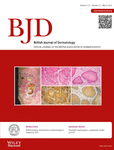

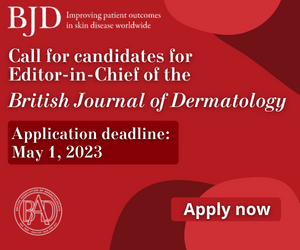
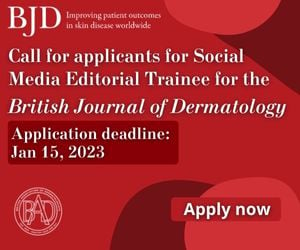

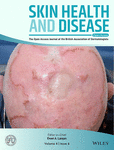
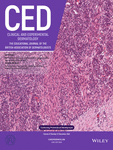
2690-442X.cover.png)